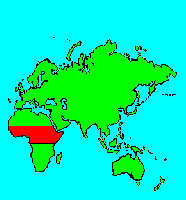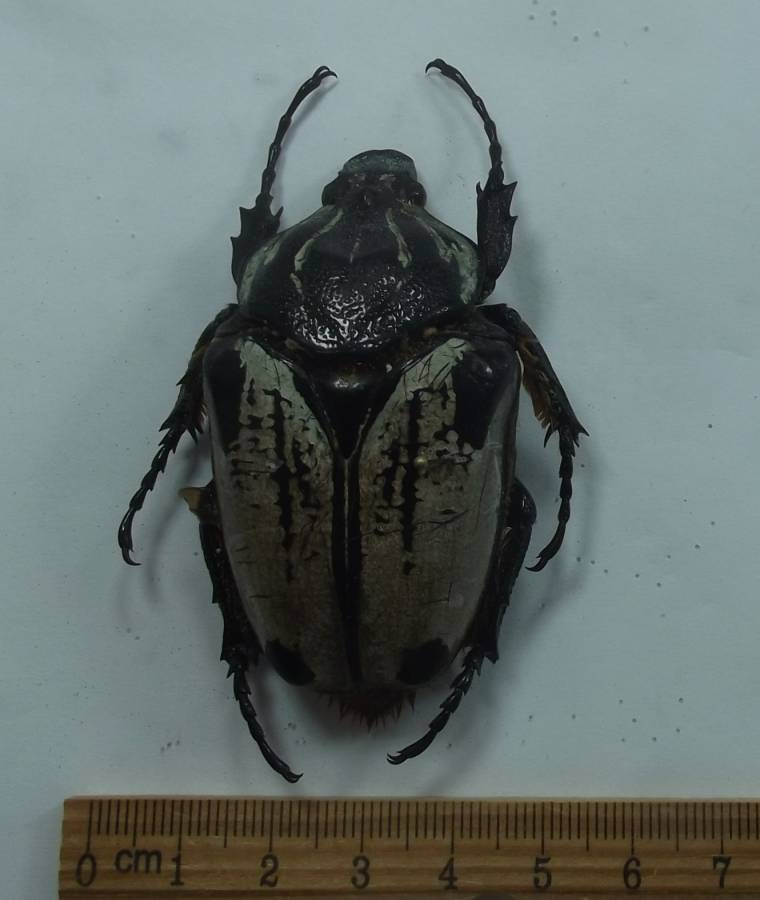SPECIES INFO
Goliathus goliathus (to Goliathus goliatus), the red Goliath beetle, is found in central Africa. The color of the elytra (hardened protective front wings) varies from red to black in normal individuals. Rare forms of this beetle are known with extensive white coloration. This beetle is frequently called the world's largest beetle.
There have been rumors of specimens near 12 cm, but Lachaume in his analysis of the species cites 11.0 cm as the maximum length. Adult Goliath beetles fly from flower to flower in search of nectar. They are very hard to catch, but can be captured in the early morning in their resting places in the trees.
The vast majority of the Goliath beetles from the vicinity of Cameroon have almost identical colors and pattern. The dark background color can be almost black or a very dark reddish color. The white marks on the thorax can be very narrow or broad. However, there arise some occasional rarities of unusual interest with very surprising color forms.
This female one is called form albatus. Usually only males are named, but it seems to be logical to name their corresponding females. Consequently, this specimen will help define the concept of apicalisThe goliath (Goliathus) genus is found only in Africa. Several species in this genus reach giant sizes, and are considered some of the most beautiful and attractive beetles known to science. Although some medium sized species are found in southern Africa and eastern Africa, there are four main large species found in western Africa.
Goliathus goliathus - Cameroon area
Goliathus cassicus - W Africa area
Goliathus orientalis - SW Africa area
Goliathus regius - W Africa area
Goliathus atlas - W Africa (Hybrid ???)
This portion of the African goliath beetles contains the following genera:
Goliathus, Mecynborrhina, Fornasinius, and Hegemus.
Included herein are several of the largest and most colorful beetles in the world. Goliathus regius and Goliathus goliatus can reach lengths well over 10.0 cm.
Beetles (Order Coleoptera) are a diverse group of insects found throughout the world. They usually can fly and typically have four wings. Two of the wings are hardened (elytra) and serve as a body cover to protect the flying wings and abdomen. Beetles begin their life as a larvae or grub that goes through a metamorphosis that turns this worm-like creature into an adult with six legs and four wings. There probably are over 500,000 species of beetles in the world. However, that number is only conjecture as the United States does not have a complete list of its known species.
The United States has relatively few exotic beetles. However, countries like Brazil, Mexico, Ghana, Zaire, Malaysia, and Peru have many beautiful beetles.
Exotic beetles are such a fascination in Europe and Japan that they are collected much as coins are collected throughout the rest of the world.
Insects (Class Insecta) are the most successful animals on Earth if success is measured by the number of species or the total number of living organisms. This class contains more than a million species, of which North America has approximately 100,000. (Recent estimates place the number of worldwide species at four to six million.)
Insects have an exoskeleton. The body is divided into three parts. The foremost part, the head, usually bears two antennae. The middle part, the thorax, has six legs and usually four wings. The last part, the abdomen, is used for breathing and reproduction.
Although different taxonomists divide the insects differently, about thirty-five different orders are included in most of the systems.
The following abbreviated list identifies some common orders of the many different orders of insects discussed herein:
Odonata: - Dragon and Damsel Flies
Orthoptera: - Grasshoppers and Mantids
Homoptera: - Cicadas and Misc. Hoppers
Diptera: - Flies and Mosquitoes
Hymenoptera: - Ants, Wasps, and Bees
Lepidoptera: - Butterflies and Moths
Coleoptera: - Beetles
Jointed Legged Animals (Phylum Arthropoda) make up the largest phylum. There are probably more than one million different species of arthropods known to science. It is also the most successful animal phylum in terms of the total number of living organisms.
Butterflies, beetles, grasshoppers, various insects, spiders, and crabs are well-known arthropods.
The phylum is usually broken into the following five main classes:
Arachnida: - Spiders and Scorpions
Crustacea: - Crabs and Crayfish
Chilopoda: - Centipedes
Diplopoda: - Millipedes
Insecta: - Insects
There are several other "rare" classes in the arthropods that should be mentioned. A more formal list is as follows:
Sub Phylum Chelicerata
C. Arachnida: - Spiders and scorpions
C. Pycnogonida: - Sea spiders (500 species)
C. Merostomata: - Mostly fossil species
Sub Phylum Mandibulata
C. Crustacea: - Crabs and crayfish
Myriapod Group
C. Chilopoda: - Centipedes
C. Diplopoda: - Millipedes
C. Pauropoda: - Tiny millipede-like
C. Symphyla: - Garden centipedes
Insect Group
C. Insecta: - Insects
The above list does not include some extinct classes of Arthropods such as the Trilobites.
Animal Kingdom contains numerous organisms that feed on other animals or plants. Included in the animal kingdom are the lower marine invertebrates such as sponges and corals, the jointed legged animals such as insects and spiders, and the backboned animals such as fish, amphibians, reptiles, birds, and mammals.


